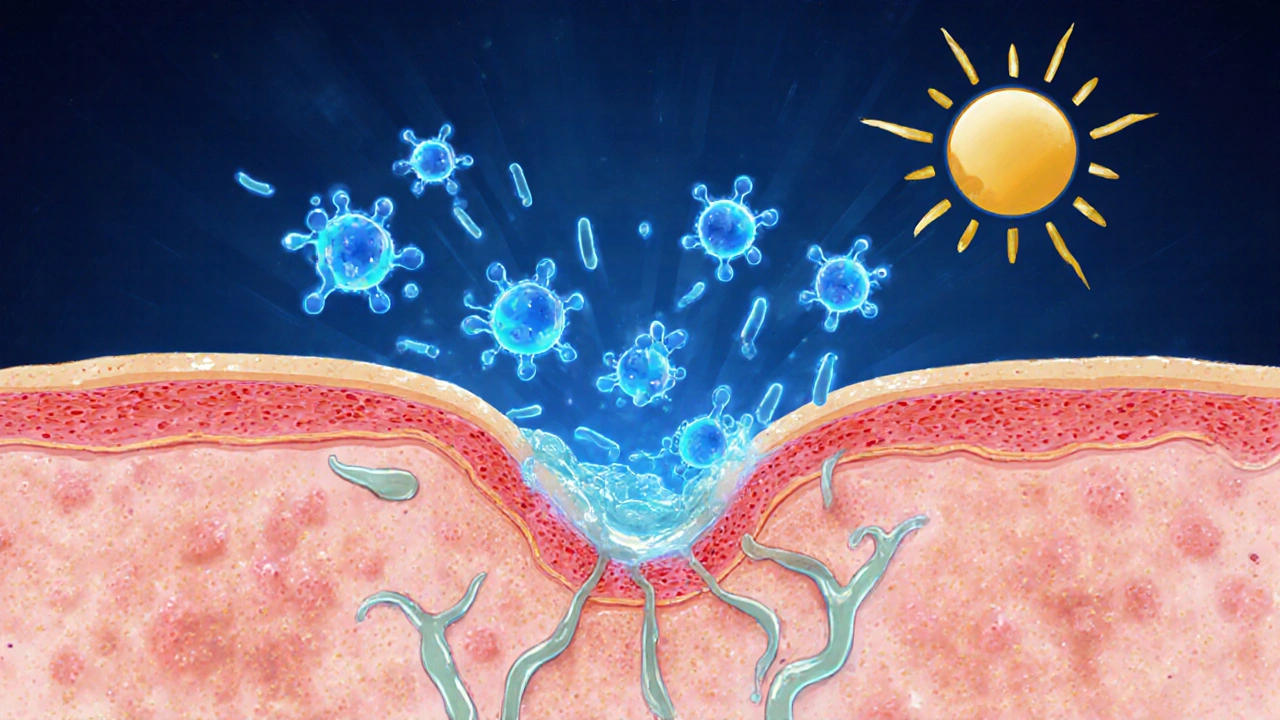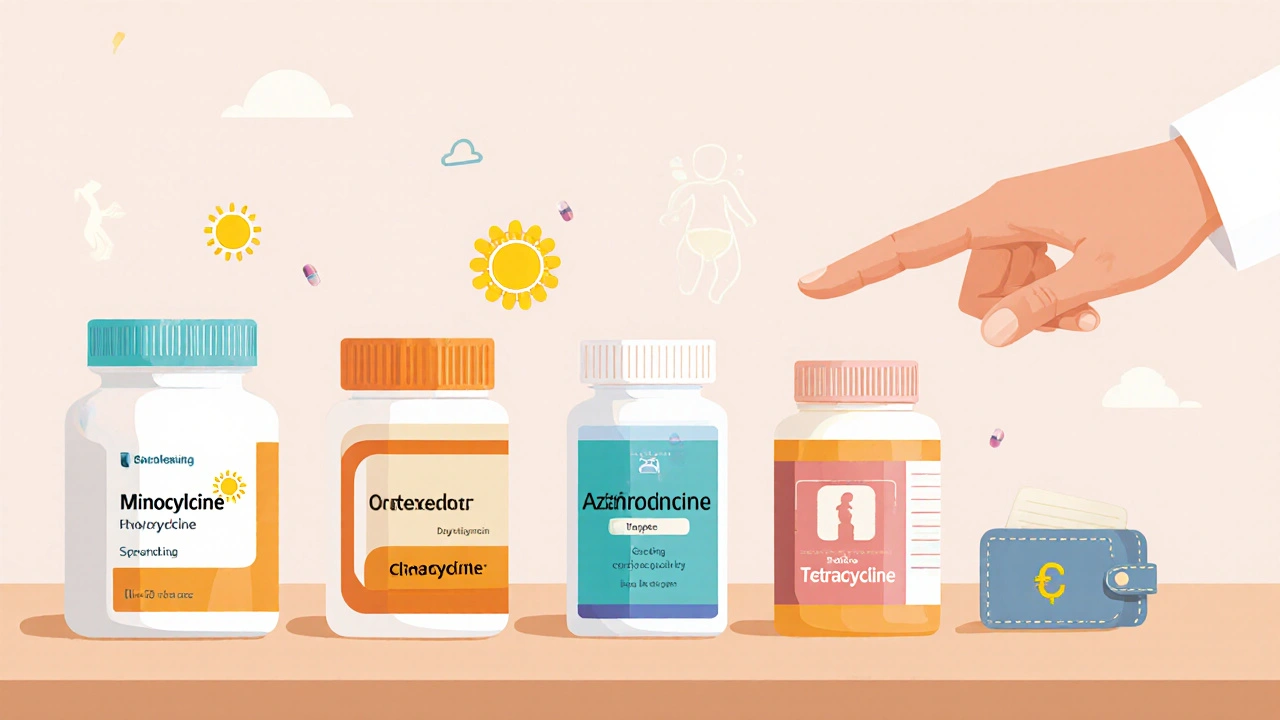Acne Antibiotic Selector
Recommended Antibiotic:
Why this recommendation?
TL;DR
- Minocycline (Minomycin) is a broad‑spectrum tetracycline‑class antibiotic most often used for moderate‑to‑severe acne.
- Key alternatives include doxycycline, tetracycline, azithromycin and clindamycin, each with its own strength and safety profile.
- Minocycline offers the longest half‑life (≈24h) and strong anti‑inflammatory action, but it carries higher risk of photosensitivity and rare autoimmune reactions.
- Doxycycline is cheaper, works similarly for acne, and is safer in pregnancy; azithromycin is useful for patients who can’t tolerate tetracyclines.
- Choose based on infection type, skin type, pregnancy status, cost, and personal tolerance to side effects.
Minocycline is a synthetic tetracycline antibiotic first approved by the FDA in 1971. It works by binding to the 30S ribosomal subunit of bacteria, halting protein synthesis and thereby stopping bacterial growth. The brand name Minomycin is marketed in Australia for oral use, primarily in the treatment of moderate to severe acne vulgaris, rosacea, and certain respiratory or urinary tract infections.
How Minocycline Works and When It’s Prescribed
The drug’s anti‑inflammatory properties make it a favorite for dermatologists. It reduces the production of inflammatory cytokines in skin lesions, which translates into fewer red bumps and quicker healing. Typical dosing for acne is 100mg once daily, taken with or without food, though some regimens start with 50mg twice daily for the first two weeks to minimize gastrointestinal upset.
Besides acne, Minocycline is employed for:
- Rosacea with papulopustular lesions.
- Chronic prostatitis.
- Localized skin infections where Staphylococcus aureus or Propionibacterium acnes are suspected.
Key Pharmacological Attributes
| Attribute | Value |
|---|---|
| Absorption | ≈95% oral bioavailability |
| Half‑life | ≈24hours (allows once‑daily dosing) |
| Distribution | Highly lipophilic - penetrates skin and sebum well |
| Metabolism | Hepatic via CYP450 enzymes |
| Excretion | Renal (≈40% unchanged) |
Common Side Effects and Safety Concerns
Most patients tolerate Minocycline well, but the drug is notorious for a few specific adverse events:
- Photosensitivity: Sun exposure can cause severe sunburn; sunscreen SPF30+ is a must.
- Vestibular issues: Dizziness or vertigo, especially during the first week.
- Autoimmune reactions: Rare cases of drug‑induced lupus or autoimmune hepatitis have been reported.
- Gastrointestinal upset (nausea, vomiting) - usually mild.
Pregnant or breastfeeding women should avoid Minocycline because it can affect fetal bone growth and cause tooth discoloration in the newborn.
Primary Alternatives to Minocycline
When Minocycline isn’t suitable-whether due to cost, side‑effect profile, or contraindications-doctors often turn to other antibiotics. Below are the most common substitutes, each introduced with its own microdata markup.
Doxycycline is another tetracycline‑class drug, approved in 1967. It shares the same mechanism of protein synthesis inhibition but has a shorter half‑life (≈18h) and is generally better tolerated in terms of photosensitivity.
Tetracycline is the original member of the class, introduced in the 1950s. Its oral bioavailability is lower (≈80%), and it requires multiple daily doses, which can affect adherence.
Azithromycin is a macrolide antibiotic that works by blocking bacterial protein translocation. It’s not a tetracycline, so it avoids the class‑specific side effects like tooth discoloration, making it a fallback for patients with tetracycline hypersensitivity.
Clindamycin belongs to the lincosamide family. It’s especially useful for anaerobic skin infections and offers a different resistance profile, though it carries a higher risk of Clostridioides difficile colitis.

Side‑by‑Side Comparison Table
| Feature | Minocycline (Minomycin) | Doxycycline | Tetracycline | Azithromycin | Clindamycin |
|---|---|---|---|---|---|
| Class | Tetracycline | Tetracycline | Tetracycline | Macrolide | Lincosamide |
| Common Acne Dose | 100mg once daily | 100mg twice daily (or 200mg once daily) | 500mg four times daily | 500mg once daily (5‑day course) | 300mg twice daily |
| Half‑life | ≈24h | ≈18h | ≈8h | ≈68h | ≈2.5h |
| Photosensitivity | High | Moderate | Moderate | Low | Low |
| Pregnancy Category | Contraindicated (D) | Category D (avoid after first trimester) | Category D | Category B (generally safe) | Category B |
| Cost (AU$ per 30‑day supply) | ≈$70 | ≈$35 | ≈$25 | ≈$45 | ≈$55 |
| Key Side Effects | Photosensitivity, lupus‑like syndrome | GI upset, yeast infection | GI upset, hepatic enzyme elevation | QT prolongation, GI upset | Diarrhea, C.difficile infection |
Choosing the Right Antibiotic for Your Situation
Not every skin condition needs the same drug. Here’s a quick decision guide:
- Severe, inflammatory acne with little sun exposure: Minocycline’s strong anti‑inflammatory effect may give faster results.
- Acne plus a need for sun protection (outdoor work, sports): Doxycycline or azithromycin are safer choices.
- Pregnancy or planning to become pregnant: Azithromycin or clindamycin are the only options with acceptable safety data.
- History of antibiotic resistance to tetracyclines: Switching to a macrolide (azithromycin) or a lincosamide (clindamycin) can bypass resistance mechanisms.
- Budget constraints: Generic tetracycline or doxycycline are the most affordable.
Practical Tips for Taking Minocycline and Its Alternatives
- Take the pill with a full glass of water. This reduces esophageal irritation.
- For Minocycline and doxycycline, avoid dairy or calcium‑rich foods within two hours of the dose, as they can bind the drug and cut absorption.
- Apply broad‑spectrum sunscreen (SPF30+) daily, especially if you’re on Minocycline or doxycycline.
- If you experience dizziness, stand up slowly and avoid driving until you know how the medication affects you.
- Complete the full prescribed course, even if skin looks clearer before the end. Stopping early fuels resistance.
- Report any persistent rash, dark urine, or joint pain to your doctor-these could signal rare autoimmune reactions.
Pitfalls to Watch Out For
Even the best‑studied drugs have blind spots. Common mistakes include:
- Self‑prescribing without a skin culture: Not all acne lesions are bacterial; hormonal or cosmetic factors may be the real cause.
- Mixing antibiotics with over‑the‑counter supplements: Iron, zinc, and antacids can lower absorption of tetracyclines.
- Skipping sun protection: A single severe sunburn can trigger long‑lasting hyperpigmentation, especially on previously inflamed skin.
- Assuming ‘generic’ = ‘cheaper’ everywhere: In some Australian pharmacies, the brand version of Minocycline may be priced similarly to generics of doxycycline.
When to See a Healthcare Professional
If you notice any of the following, book an appointment promptly:
- Rash that spreads beyond the face or neck.
- Severe stomach pain or persistent nausea.
- Joint swelling, fever, or unexplained fatigue.
- Signs of an allergic reaction: hives, swelling of lips or tongue.
These could indicate a rare but serious adverse event that needs medical assessment.

Frequently Asked Questions
Is Minocycline stronger than Doxycycline for acne?
Both drugs are effective, but Minocycline often works faster because it penetrates oily skin better and has a longer half‑life. The trade‑off is higher photosensitivity and a rarer risk of autoimmune reactions.
Can I take Minocycline while on birth control?
Yes, Minocycline does not reduce the effectiveness of hormonal birth control, but you should still use a reliable method and discuss any concerns with your doctor.
What should I do if I get a sunburn while on Minocycline?
Immediately treat the area with cool compresses, aloe gel, and a high‑SPF sunscreen. If the burn is severe or blisters develop, see a clinician-sometimes a short break from the antibiotic is recommended.
Is azithromycin a good fallback for patients allergic to tetracyclines?
Azithromycin works differently and is safe for most tetracycline‑allergic patients. However, it’s less anti‑inflammatory, so results may be slower for acne.
How long should a typical acne course of Minocycline last?
Most dermatologists prescribe 3‑4 months, reassessing skin response at the 6‑week mark. If no improvement occurs, a switch to another antibiotic is usually advised.
Choosing the right acne antibiotic boils down to balancing efficacy, side‑effect tolerance, cost, and personal circumstances. Minocycline (Minomycin) remains a potent option for many, but alternatives like doxycycline, azithromycin, and clindamycin provide valuable backups when the primary drug isn’t a fit.


Jada Singleton
October 3, 2025 AT 17:20While the article presents a thorough tabulation, it neglects the practical realities of patient adherence. The emphasis on pharmacokinetic minutiae feels detached from the daily struggle of skin‑type variability. Moreover, the cost analysis omits regional pricing disparities that can turn a "budget‑friendly" option into a financial burden. A more balanced discussion would integrate lifestyle factors alongside the raw data.
Emily Rossiter
October 8, 2025 AT 17:20Thanks for laying out the side‑effect profiles so clearly; it makes the decision‑making process a lot less intimidating. Remember to pair any oral antibiotic with a good moisturizer and sunscreen to keep the skin barrier happy.
Renee van Baar
October 13, 2025 AT 17:20Choosing the right acne antibiotic depends on a handful of personal variables. In addition to the pharmacologic potency, one must weigh the patient’s Sun exposure habits, potential for drug interactions, and any underlying autoimmune tendencies that could be exacerbated by a tetracycline. The literature suggests that while Minocycline delivers superior anti‑inflammatory effects, its heightened photosensitivity risk makes it less suitable for outdoor enthusiasts, prompting many clinicians to favor Doxycycline for its more moderate phototoxic profile. When pregnancy is a concern, the avoidance of class D agents altogether steers the prescription toward Azithromycin or Clindamycin, both of which have been shown to maintain efficacy without the teratogenic warnings associated with tetracyclines. Ultimately, a shared decision‑making conversation that incorporates these nuanced considerations will yield the most satisfactory therapeutic outcome for the individual.
Janice Rodrigiez
October 18, 2025 AT 17:20Minocycline is a powerhouse drug that dives deep into oily pores and knocks out inflammation with fierce efficiency
Roger Cardoso
October 23, 2025 AT 17:20One should question why pharmaceutical giants push Minocycline so hard when cheaper, equally effective alternatives sit on the shelves unheard; the profit motive often shadows genuine patient care.
barry conpoes
October 28, 2025 AT 16:20From an American standpoint we deserve access to affordable acne solutions, and Doxycycline offers that without the pricey brand markup that Minocycline carries.
Kristen Holcomb
November 2, 2025 AT 16:20I noticed that many patients forget to avoid dairy around their dose, which can really cut down the absorption of the drug and make the treatment feel less effective.
justin davis
November 7, 2025 AT 16:20Oh great, another endless list of side‑effects, because we all love reading about photosensitivity, dizziness, lupus‑like syndrome, and the occasional bout of nausea, right?,,
David Lance Saxon Jr.
November 12, 2025 AT 16:20From a pharmaco‑dynamic perspective, the trade‑off between half‑life extension and immunomodulatory risk in Minocycline embodies the classic Yin‑Yang equilibrium of therapeutic design, wherein the desire for prolonged receptor occupancy collides with the specter of auto‑immune perturbation.
Moore Lauren
November 17, 2025 AT 16:20Stick with the regimen, stay consistent, and you’ll see clearer skin in a few weeks.
Jonathan Seanston
November 22, 2025 AT 16:20Hey there, just wanted to say the table you made is super helpful for anyone scrolling through late at night trying to pick a pill.
Sukanya Borborah
November 27, 2025 AT 16:20Honestly, the article could’ve dropped the whole “brand‑specific” marketing fluff and just given us the raw numbers, because who cares about the fancy name when the chemistry is the same.
bruce hain
December 2, 2025 AT 16:20While comprehensive, the piece omits a discussion of resistance patterns.
Stu Davies
December 7, 2025 AT 16:20Great summary! 👍🌟
Nadia Stallaert
December 12, 2025 AT 16:20It is a well‑known fact that the pharmaceutical industry operates behind a veil of secrecy. The very molecules we trust are often engineered with hidden agendas. The sun’s unforgiving rays become a weapon when paired with Minocycline. Patients are left to navigate a labyrinth of side‑effects nobody mentioned in the glossy brochures. The promise of quick clearance is entangled with the risk of lupus‑like syndromes. Every prescription carries the weight of an ancient alchemical pact. Regulatory bodies turn a blind eye to the subtle, yet insidious, auto‑immune triggers. Clinicians are forced to balance efficacy against a cascade of potential complications. The cost factor silently dictates who gets the "best" drug and who settles for a generic. The narrative in mainstream dermatology often glorifies a single drug without acknowledging the socioeconomic divide. The very act of taking a pill becomes a daily reminder of vulnerability. Sunlight, once a source of life, becomes a lethal foe for those under Minocycline’s influence. Myths surrounding "stronger" antibiotics perpetuate a cycle of overprescription. Patients deserve transparent data, not marketing gloss. An informed choice is the only true empowerment we can offer.
Greg RipKid
December 17, 2025 AT 16:20I appreciate the passionate warning; it’s a reminder to read the fine print before committing.
John Price Hannah
December 22, 2025 AT 16:20Honestly, the drama never ends, and every new drug feels like a plot twist in a medical thriller!